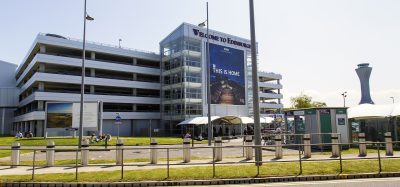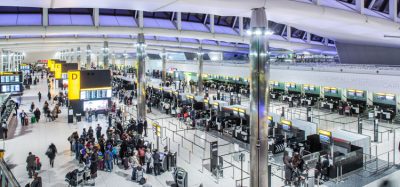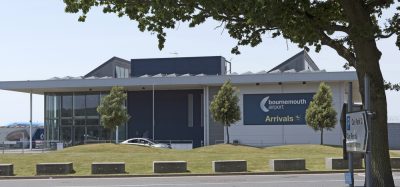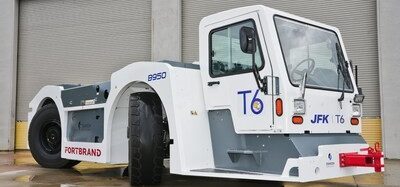A380 GSE requirements
Posted: 25 November 2005 | Jose Francisco Cerdó Cuesta and Dr. Thilo Stilp, Ground Operations Senior Engineer, Manager Ground Operations & Environment, Airbus A-380 Programme | No comments yet
Airbus’ collaborative approach is helping introduce into service the world’s largest commercial airliner.
Airbus’ collaborative approach is helping introduce into service the world’s largest commercial airliner.
Half a year after the Airbus A380 first flight, on April 27th, and with 159 firm orders from 16 customers booked, the preparation for entry into service at the end of 2006 continues at a rapid pace. A380 customers expect to receive a reliable, mature aircraft with the capability to fit seamlessly into their existing ground operations environment, from day one. Key components in validating this design goal are the Airport Check exercises. To date, the first two development aircraft have carried out six of these voluntary checks. The value of the checks is well recognised from feedback on similar exercises performed with other large Airbus aircraft, such as the A340-600.
The first airport check exercise was completed successfully on the 29th October at Frankfurt, one of over 60 airports that the A380-800 will serve by 2010. Several ramp scenarios were simulated, based around the standard layout with upper deck catering. Other equipment, not normally part of the normal turn around process were also tested as well as multiple pieces from different manufacturers. In total around 40 different pieces of GSE were used. This compares to around 21 for a standard turn around.
Join us live: Shaping the Next Generation of Hold Baggage and Air Cargo Screening
Join us live for an insightful webinar on 11th December at 14:00 GMT, in collaboration with Smiths Detection, as we explore the strategic balance of operational efficiency, regulatory compliance, and sustainability in high-volume security environments.
This session offers a focused look into future-proofing your security strategy.
Key learning points
- Cost Reduction: Strategies to minimize bag travel time while simultaneously reducing operational costs.
- Regulatory Roadmap: Insights into the next wave of regulatory changes and their impact on future investment decisions.
- Sustainable Systems: Practical approaches to building sustainability into security systems and lowering the total cost of ownership (TCO).
- Scalable Solutions: Real-world examples of scalable systems supporting current airport growth and preparing for tomorrow.
Register now for expert insights, case studies, and actionable strategies on operational efficiency!
The gate used, E9 at Terminal 2 is equipped with two boarding bridges, with the second able to reach the upper deck. As the aircraft used in the tests, MSN 4 (one of five in the flight test programme) was not equipped with a cabin; boarding was restricted to the flight test crew. Full scale, timed, turn around tests including passenger boarding and cargo handling will be conducted during the route proving flights due to take place in mid 2006.
With mostly standard wide body aircraft compatible equipment used in the tests, the outcome of the day is best summarised by the words of the vehicle operators involved: “It’s just like handling another Airbus aircraft”.
The following sections will describ the individual processes during an A380 turn around with illustrations from the tests at Frankfurt. We would like to thank all of those involved in the tests for their professional approach and valuable feedback.
Ramp layout overview
To illustrate the similarities between handling the A380 and other existing widebody aircraft it is worth examining the types and numbers of equipment required during a normal turn around. The standard layout contained in the A380 Aircraft Characteristic for Airport Planning (AcfAP) document, available on the Airbus website (link at the end of this article) shows 21 pieces of GSE. For comparison, the equivalent document issued for the B747-400 shows 19 pieces of equipment.
Handling the A380 on the ground requires one additional catering truck (serving the upper deck directly) and one additional cleaning vehicle. So the number of pieces of equipment is similar, as is the overall layout. This is no coincidence; ground operation activities were taken into account during the early stages of the design of the A380. The position and heights of the ground connectors and servicing doors were chosen carefully and in conjunction with the airlines and handlers who will service the aircraft.
The only real difference that the A380-800 brings to the ramp lies in two new pieces of equipment, an upper deck catering vehicle and a heavier tow tractor. Before looking at these specific units it is worth first covering the equipment and processes which are common with existing wide body aircraft.
Standard GSE for A380 TRT
Electrical Power: 4×90 kVA standard external ground power connectors (ISO 461) are located just behind the nose landing gear. Power demand during a normal aircraft turn is foreseen to stay below 300 kVA, but this depends on the cabin services (IFE, Galleys, etc) that the airline wants active while on stand. It is worthwhile to note that the power supply should be in any case via multiples of 90 kVA, connection of units offering less than 90 kVA per connector (e.g. split 140 kVA units) is not recommended.
Pre-conditioning air: The A380-800 offers four standard connectors (ISO 1034) for supplying the aircraft with pre-conditioned air. The mass-flows required to achieve and maintain desired cabin temperatures can be obtained from the respective charts published in the AcfAP. The maximum intake mass flow shall, however, be limited to a total of 6.5 kg/s.
Cargo loading: The total capacity of the A380 lower deck forward hold compartment is 22 LD3s or 7 96”x125”x64” pallets, while the rear compartment can accommodate 16LD3s or 6 96”x125”x64” pallets. The ratio between LD3s and pallets will, however, depend on the layout and cargo emphasis of each individual airline.
Operation of the lower deck cargo door, as well as the dimensions and sill heights are comparable to other Airbus widebody aircraft. Height of the cargo doorsill will vary between 3.05 metres and 3.30 metres (depending on the load condition). The standard high loaders which are currently used to service wide body aircraft can accordingly be used with the A380 as well.
Refuelling: The maximum fuel capacity of the A380 is approx. 315.000 litres. As a reference, the block fuel for a nominal range mission (555 Pax, 8000nm) will be around 261,200 litres.
Two standard refuel couplings are placed at each wing (approx. 18m outboard from the aircraft centre line). Their maximum height will be at 5.94 metres, making them easily reachable with existing fuel dispenser vehicles that have operator platforms which can be raised to 4 metres. Pressure at the connector shall be kept to under 50 psi.
The refuel control panel is located in the rear part of the belly fairing, offering the operator good visibility on both connectors. Its layout will look familiar to any experienced operator. The height of the panel is approx. 2m high, making it easily accessible from the ground.
Engine Start: There is a choice of two engines for the A380, the RR Trent 900 and EA GP7200, each with a nominal thrust of 70,000lb. Up to three high pressure standard connectors are available, starting can be done either using all three or only two of them. Air mass flow requirementscan be found in the chapter 5.5 of the ACfAP, a value of 2 g/s at around 3 bars can be taken as a reference (As shown in the ACfAP chapter 5.5 pneumatic engine start requirements depend on several parameters: time, outside temperature, altitude).
Cabin Servicing: With most cabin servicing to the main deck of the A380, which has an equivalent sill height to other wide body aircraft, existing catering and cleaning vehicles can be used. The exception is the upper deck catering vehicle, which is covered in the next section. Typical A380 cabin layouts have seat counts between 35 and 40 percent higher than the 747-400, therefore an additional catering and cleaning vehicle are required. The standard ramp layout sees conventional catering vehicles servicing main deck doors M2R, M4R and M5L as well as an upper deck catering vehicle serving upper deck door U1R. Two cleaning vehicles serve main deck doors M1R and M4L.
It is important to note that individual airlines might have some variations on this standard ramp layout based upon their cabin layouts and operational requirements.
Numerous GSE that satisfies the above requirements is already in use at airports today to service existing wide body aircraft. To determine the compatibility of a certain piece of GSE for use with A380, it is recommended to check the manufacturer’s specification in detail against the requirements as stated the A380 AcfAP.
Specific GSE for A380 TRT
Although new for the A380, the following pieces of equipment are also fully compatible with other wide body types. This was a clear requirement from the airlines and handlers that helped define these units.
Towing: Carrying 35 percent more passengers 900 nm further than the 747-400 means that the A380 also has a higher maximum take-off and hence ramp weight (MTOW and MRW). Although this extra weight does not result in higher pavement loading than say the 777-300ER (the A380 has more wheels to spread its weight), it does necessitate heavier and more powerful tow tractors. This is especially the case if push back at MRW and under low tractive conditions is to be achieved. The key parameters pertinent to towing the A380 are listed below.
- The maximum ramp weight (MRW) of the A380 is 562 tonnes.
- Nose Landing Gear (NLG) is provided with a CAT V fitting. Fitting categories and dimensions can be found in the SAE 1614.
- NLG gear size is 1270x 455R22 32PR.
- Maximum NLG weight?41.5 T.
- Tow bar requirements, pin tensile and torque limits already defined (620 KN and 48 KNm)
Airbus has ensured that this information hits the right audience by organising dedicated working groups, which allowed airlines, manufacturers and ground handlers to define the requirements for the upcoming models. Five such meetings were held and have now been successfully concluded.
Both conventional and towbarless models are available and can be used with the A380, the relative merits and de-merits of using conventional versus towbarless tractors are as for all other wide-body aircraft and a detailed discussion goes beyond the scope of this article.
A380 capable conventional tractors require more effective ‘push capacity’ to be able to handle the aircraft at MRW and with poor surface friction coefficients. This ‘push capacity’ is mainly determined by two tractor characteristics: its power and its weight. A380 capable units should weigh around 70 tonnes and have engines with around 300 hp (figures calculated following ISO 7717 assumptions) to be able to handle the A380 at MRW and under poor surface friction characteristics. At weights below MRW and/or with good surface friction, it is also possible to use existing wide body units.
Due to its larger nose landing gear (NLG) wheel, existing towbarless tractors cannot handle the A380 and accordingly new models needed to be designed. The towbarless concept takes advantage of the NLG weight to minimise tractor ballast. Again, necessary design parameters were shared with the industry at a very early stage in the course of the dedicated A380 towing working group and as a result, five manufacturers are today offering suitable models within their product line. Some of these types are in fact already in service.
In contrast to the conventional tractors where the interface between the tractor and the aircraft is via a dedicated towbar which contains the relevant safety devices (shear pins) to protect the aircrafts NLG against undue stress, the towbarless tractors interface directly with the aircraft NLG. These units therefore need to be qualified prior to being used on the A380 on a regular basis. The towbarless tractor qualification procedure is a standard practice today for all Airbus and Boeing aircraft and ensures that the pushback and towing manoeuvres will not adversely affect the NLG life cycle.
Upper deck catering: The A380 is equipped as standard with trolley lifts at the M2 and M5 galleys, to allow transport of catering trolleys from the aircraft main to upper deck. Servicing of the aircraft via the main deck only could therefore be possible. So why have direct upper deck catering? The answer is time. With almost all airlines having their largest galley blocks at the M2 and U1 positions, the ability to access both directly, therefore avoiding the use of the trolley lift, can save up to 36 minutes (Based on A380 standard reference cabin layout of 555pax – see also article in IAR issue 2, 2005). As catering is in the critical turn around path, the overall turn around time is also reduced by 36 minutes. With 2 standard passenger boarding bridges to the main deck of the aircraft, the use of upper catering allows the A380 to achieve a turn around time of 90 minutes(again, see previous article), comparable to the 747-400, though with 35 percent more passengers boarded.
Other doors on the aircraft UD could also be considered for direct servicing but the galley locations and sizes of most A380 customer airlines are such that servicing them would not bring a time benefit.
The fact that 9 vehicle manufactures have announced the availability of prototype vehicles before entry into service, is testament to the cooperation between Airbus, the airlines, caterers, and vehicle manufacturers. The upper deck catering working group, organised by Airbus, was successfully concluded in the summer of this year after eight meetings. During these meetings, different concepts were analysed and basic functional requirements have been defined. IATA has also developed a dedicated AHM standard (926) in its 2005 issue. A new ISO standard on UD catering vehicles is also under development.
Again, as for all other GSE, the choice of a particular unit will depend on the detailed specifications and requirements of the purchaser. Specific aspects that may be taken into account in making the choice include:
- Capability of the unit to safely interface with A380 door U1R
- Ease and safety of positioning process including clearances to engines, wing leading edge and adjacent GSE
- Certified wind stability (if applicable under local regulations)
- Specific safety features/devices to protect aircraft and personnel
Airbus is offering to the industry the possibility to test their units at a dedicated 1:1 mock-up of the A380 at its main base in Toulouse, France. Furthermore, tests of several UD catering vehicle prototypes have been carried out directly on the A380 during the ramp check in Frankfurt, demonstrating impressively the maturity and safety of this new catering concept.
Direct Upper Deck Access (DUDA): Although not a piece of GSE, the unique possibility of using upper deck capable passenger boarding bridges deserves mention.
The A380 is the world’s first twin-aisle, twin-deck airliner and many of our customer airlines, as well as destination airports, have recognised the unique product differentiation benefit of boarding passengers directly onto its upper deck. Upper deck boarding can be achieved with two or three bridges serving a combination of the M1L, M2L and U1L doors. Although upper deck access may not always bring a turn around time benefit, most A380 destination airports are planning some form of upper deck access to enhance passenger service levels. Both, they and the airlines especially want to offer premium class passengers, who will be seated mostly on the upper deck of the aircraft, a truly new experience.
Don’t forget the A380F
The freighter version of the A380, the A380F, was launched at the same time as the passenger aircraft in December 2000. In fact, 27 of today’s 159 firm A380 orders are for the A380F, with production of the first aircraft, the so called ‘first metal cut’, having started in April. The A380F carries 150 tonnes, 1400nm further than the 747-400F. With a MRW of 592 tonnes it will be even heavier than the A380-800 but it has nonetheless been designed with efficient ground handling in mind.
Servicing the A380F will require only one new piece of GSE, namely an upper deck cargo loader. The upper deck cargo door is positioned on the left hand side of the aircraft, forward of the wing.
As for other new A380 equipment, Airbus has collaborated closely with the GSE industry and international bodies to ensure the availability of the upper deck cargo loaders well before the aircraft’s entry into service. After four working group sessions, two manufacturers have already committed to have prototypes available in 2006, more than two years in advance of entry into service in mid 2008. With an increased pallet carrying capability, these new generation loaders are more productive than current main deck units, and will thus bring a considerable reduction in turn around times to other wide body freighters as well. As for UD Catering vehicles, a functional specification for this new piece of equipment is already available in the 2005 version of the Airport Handling Manual (AHM930).
The A380F main deck cargo door is also located on the left hand side of the aircraft but aft of the wing. The sill height of this door is similar to that of existing wide body freighters and can be serviced with existing main deck high loaders At 34”, it is wider than that of the 747-400F, thus allowing out-sized cargo to be easily loaded into the main deck cargo compartment. Lower deck cargo holds of the A380F are identical to those of the passenger aircraft. The configuration of the A380 main and upper deck cargo doors allows simultaneous and separate loading of the upper and main deck cargo compartments, thus allowing similar turn around times to be achieved to the 747-400F.
Although a detailed description of A380F ramp operations is out of the scope of this article, more information can be found in the A380 AcfAP manual. Further articles focusing solely on the A380F can be expected as the aircraft nears its first flight in mid 2007.
The countdown continues
There is no question that 2005 has been the year of the A380, with many significant and historic milestones achieved. To date, three out of the five development aircraft have amassed more than four hundred hours of flying time and a total of 11 aircraft (including 2 structural test specimen) have been assembled. The first major international airport has had its first A380 visit with more than 60 more preparing for their first scheduled service.
There are clearly many exciting times to come in the coming months. The route proving campaigns in particular will provide us, our customer airlines, the airports and the ground handlers with valuable knowledge and experience. Our contact with the ground handling community will continue too, in conjunction with our customer airlines through a more general Ground Handling working group. These will ensure that all relevant information is passed to those who will service the aircraft.
This well proven collaborative approach will be pursued further and, no doubt, ultimately result in the smooth and successful entry into service of the world’s largest commercial airliner.
Please note that the specific equipment shown in this article do not represent an Airbus endorsement for the equipment shown.
References:
www.airbus.com/store/mm_repository/pdf/att00004248/media_object_file_AC_A380.pdf
Dr Thilo Stilp
Dr Thilo Stilp holds a a Doctoral Degree in Physics from the University of Heidelberg, specialising in the impact of aviation on atmosphere and climate. Dr Stilp joined the Airbus A380 programme in 2000 as an environment manager responsible for the wake turbulence issues of the A380 after. Since 2001 he has been Head of the Ground Operations and Environment Group within the A380 programme. Email: [email protected]
Jose Francisco Cerdo-Cuesta
Jose Francisco Cerdo-Cuesta has worked for Airbus since 2004, within the A380 Ground Operations & Environment Group, responsibe for A380 related GSE. His University studies include ” Ingeniero aeronautico” (Aeronautical Enginner), issued by the Universidad Politecnica de Madrid (Polytechnic University of Madrid) and a final thesis wrote in Cranfield University, College of Aeronautics.
Stay Connected with International Airport Review — Subscribe for Free!
Get exclusive access to the latest airport and aviation industry insights from International Airport Review — tailored to your interests.
✅ Expert-Led Webinars – Gain insights from global aviation leaders
✅ Weekly News & Reports – Airport innovation, thought leadership, and industry trends
✅ Exclusive Industry Insights – Discover cutting-edge technologies shaping the future of air travel
✅ International Airport Summit – Join our flagship event to network with industry leaders and explore the latest advancements
Choose the updates that matter most to you.
Sign up now to stay informed, inspired, and connected — all for free!
Thank you for being part of our aviation community. Let’s keep shaping the future of airports together!

















